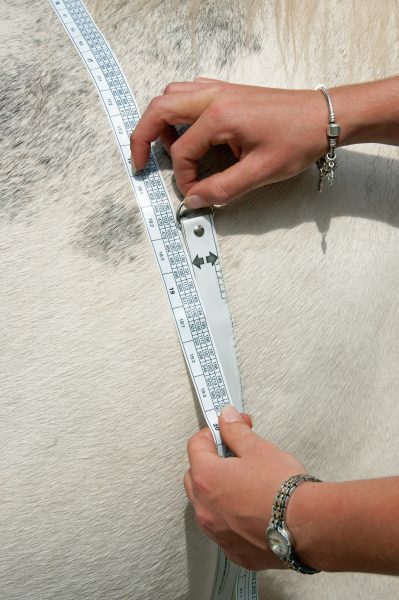Farming

During the winter, horse owners may wonder if they have enough forage to last until their pastures regrow. The best practice for determining forage needs over the winter is to calculate the horse’s body weight, estimate intake, and calculate how many months hay will be fed.
These simple calculations, and an evaluation of the horse’s current diet, can help owners determine the nutritional needs of their animal and will help them to maintain body condition and weight, while also reducing costs and forage wastage. These calculations can also help owners plan when to purchase hay from their supplier before winter begins; however, not every owner has the means or storage space to buy large amounts of hay at one time.
Evaluating Equine Body Condition
Evaluating a horse’s body condition can help owners determine whether their nutritional program is sufficient. The Henneke Body Condition Scoring (BCS) System ranges from 1 to 9 and is a visual and tactile appraisal of fat. For optimal health, most horses should have a BCS of 5 or 6. For more information on BCS, see the publication “Body Condition Scoring as Equine Management Tool” (ANR-1353) on the Alabama Extension website at www.aces.edu.
Estimating a horse’s weight can also aid in making informed nutrition decisions. Numerous commercial weight tapes, equations, websites, and phone applications can help estimate weight. There are differences among the methods, and some are more accurate than others. Producers should select the weight estimation method that works best for them and continue using it to maintain accuracy.
Estimating Forage Needs

Figure 1. Estimating a horse’s weight can help producers make informed decisions on how much forage to feed their horse.
Forage should be the foundation of every equine diet. It is available in numerous forms including pasture, hay, haylage, silage, chaff or chopped hay, hay pellets, hay cubes, and fodder/sprouts. Forage has numerous benefits including maintaining gut health and function, keeping a horse preoccupied, mimicking natural small and frequent meals, providing energy, and aiding in keeping the horse warm during the winter. The fermentation of forage by the microbes living in the horse’s hindgut naturally produces heat. This warms the horse from the inside out, which is a plus during the winter.
Not all forages are created equal. In general, legumes have the highest nutrient content, followed by coolseason grasses and then warm-season grasses. This means that an owner may have to feed more of a less nutrient-dense forage to maintain their horse’s condition. More information on forage species, seasonal distribution of forages, and soil fertility, which directly impacts forage nutrient density, can be found in the Alabama Forage Basics Handbook (ANR-2845), free at www.aces.edu. The only way to know the nutrient density of forage is through testing. This is conveniently offered by the Soil, Forage, and Water Testing Laboratory at Auburn University. For instructions on accurately obtaining forage samples, contact your county Extension office, animal sciences and forages Extension agent, or access “Collecting Forage Samples for Laboratory Analysis” (ANR-2224) at www.aces.edu.
Once a horse’s BCS and weight have been assessed, owners can estimate how much forage the horse should be receiving. When left to their own devices, the average horse will consume between 2 and 2.5 percent of their body weight in dry matter per day. Dry matter is when moisture is removed and is approximately 10 percent for hay and 80 percent for fresh, immature pasture. Some horses can even consume more than 3 percent of their body weight per day. The absolute minimum amount of forage a horse should receive is 1 percent of their body weight per day, which is a percentage usually reserved for horses in heavy work and on high-concentrate (grain-based) diets.
As a starting point, a recommended target feeding rate is approximately 2 percent of a horse’s body weight per day. If the horse is dropping weight or BCS, more forage can be added, or concentrates can be supplemented into the diet. Many owners offer free-choice hay throughout the winter, but some horses may overeat and become obese, which can be detrimental to their health. This may also be cost prohibitive for producers, depending on the number of horses they are feeding and hay wastage.
Feeding round bales in a feeder, such as a ring, basket, or cradle, can also reduce wastage. Round bale nets can be used alone or with feeders; however, nets should always be used with a feeder if horses are shod, wearing halters or blankets that might get caught in the net, or the net is in poor repair. Another benefit of nets is that they can slow hay intake to a more reasonable level and prevent horses from diving headfirst into round bales, which can expose them to dust or aggravate their eyes. Square bales can also be fed in feeders and covered in nets to reduce waste and extend intake throughout the day. If an owner is feeding smaller amounts at a time, such as flakes of hay, then using a hay net or bag can also be beneficial.
Owners can extend their forage supply by incorporating forage alternatives, such as hay pellets or cubes, into their horse’s diet. Like commercially available concentrates, pellet and cube manufacturers are required to include guaranteed levels of protein, fat, and fiber on the feed tag. This can be advantageous over hay, where quality can change from bale to bale or field to field. In theory, hay pellets and cubes can be fed as the sole forage component of a diet; however, it is important to remember that the horse’s digestive system is designed to eat small, frequent meals throughout the day. When a horse’s pellet or cube ration is fed in one or two feedings, horses may be left with long periods of time on an empty stomach, which can contribute to gastric ulcers or lead to boredom-related behaviors like wood chewing.
Adding Byproducts
Numerous feed companies use byproducts from commercial agriculture production that make high-quality forage sources for horses. Some people may be leery of the term byproduct, but many of these are safe to feed horses and are highly fermentable, benefit hindgut health, and are cost effective.

Figure 2. Many people choose to soak beet pulp to form a mash. Soaking is necessary for horses that bolt their feed or have poor dental health.
Soybean hulls are often added to commercial feeds to increase fiber content. They are generally available in their normal hulled form or in pellets and can safely replace up to 75 percent of a horse’s daily forage needs. Beet pulp is a byproduct of the sugar beet industry and is well known by many equine producers. It is considered a “super fiber” because it is readily fermentable due to its high pectin content, has a higher energy density per pound than most forages, and does not cause a significant glycemic response. Beet pulp comes with or without added molasses, in shredded or pelleted forms, and can safely replace up to 55 percent of a horse’s daily forage requirement.
Many people feel strongly about adding water to hay pellets, cubes, and beet pulp. For horses that bolt their feed or have poor dentition or missing teeth, producers should add water to the feed to make chewing easier and ensure adequate moisture before swallowing. There is no disadvantage to adding water to feed, and encouraging a little extra water during the winter is beneficial. Some horses will not consume feed if too much water is added, so evaluating an individual horse’s preference is important. It is also important to remember that these feedstuffs should be weighed dry.
If incorporating large amounts of an alternative forage source, consider feeding more frequent meals, such as three per day. This will help mimic the ideal small, frequent meals horses are designed to consume.
When incorporating anything new into a horse’s diet, do so gradually. There is no harm in transitioning or adding new feedstuffs slowly, but adding new feedstuffs rapidly may be detrimental. Remember, a daily forage consumption target rate should be at least 2 percent of a horse’s body weight. Allowing horses to display normal grazing behavior with small meals throughout the day is important, so consider adding at least a lunchtime meal to aid in this.
Conclusion
Owners can assess their horse’s BCS and weight to determine how much forage they should consume per day. This useful information can help with planning for times when pasture is limited to ensure their horse meets their minimum daily forage requirement. Forage alternatives can be included to help cost-effectively extend hay supplies until pastures regrow or can be used year-round in an equine operation. Although these suggestions are guidelines and horse requirements may vary, these tools can be valuable to producers when estimating their horses’ forage needs.
Table 1. Daily Forage and Forage Replacement Recommendations for Horses (Dry Matter)
| Horse Weight | Minimum Pounds of Forage (1% Body Weight) | Recommended Pounds of Forage (2% Body Weight) | Maximum Pounds of Soybean Hulls as Forage Replacement | Maximum Pounds of Beet Pulp as Forage Replacement |
|---|---|---|---|---|
| 900 pounds | 9 | 18 | 13.5 | 9.9 |
| 1,000 pounds | 10 | 20 | 15 | 11 |
| 1,100 pounds | 11 | 22 | 16.5 | 12.1 |
| 1,200 pounds | 12 | 24 | 18 | 13.2 |
Table 2. Recommended 30-Day Forage Consumption for Horses (Dry Matter)
| Horse Weight | Pounds of Forage (2% Body Weight) | Number of 50-Pound Square Bales | Approximate Amount of 1,000-Pound Round Bales Consumed (Free Choice)* |
|---|---|---|---|
| 900 pounds | 540 | 11 | 68 percent |
| 1,000 pounds | 600 | 12 | 75 percent |
| 1,100 pounds | 660 | 14 | 83 percent |
| 1,200 pounds | 720 | 15 | 90 percent |
 Courtney Heaton, Lecturer and Equine Extension Specialist, Animal Sciences and Forages, Auburn University
Courtney Heaton, Lecturer and Equine Extension Specialist, Animal Sciences and Forages, Auburn University
Revised August 2025, Estimating & Supplying Equine Forage Requirements, ANR-3153

